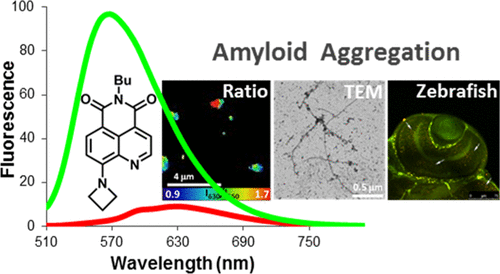Our official English website, www.x-mol.net, welcomes your
feedback! (Note: you will need to create a separate account there.)
Environment-Sensitive Probes for Illuminating Amyloid Aggregation In Vitro and in Zebrafish.
ACS Sensors ( IF 8.2 ) Pub Date : 2020-06-18 , DOI: 10.1021/acssensors.0c00587 Francisco Fueyo-González 1 , Juan A González-Vera 1, 2 , Ibon Alkorta 1 , Lourdes Infantes 3 , Maria Luisa Jimeno 4 , Paula Aranda 5 , Dario Acuña-Castroviejo 5, 6 , Alvaro Ruiz-Arias 2 , Angel Orte 2 , Rosario Herranz 1
ACS Sensors ( IF 8.2 ) Pub Date : 2020-06-18 , DOI: 10.1021/acssensors.0c00587 Francisco Fueyo-González 1 , Juan A González-Vera 1, 2 , Ibon Alkorta 1 , Lourdes Infantes 3 , Maria Luisa Jimeno 4 , Paula Aranda 5 , Dario Acuña-Castroviejo 5, 6 , Alvaro Ruiz-Arias 2 , Angel Orte 2 , Rosario Herranz 1
Affiliation

|
The aberrant aggregation of certain peptides and proteins, forming extracellular plaques of fibrillar material, is one of the hallmarks of amyloid diseases, such as Alzheimer’s and Parkinson’s. Herein, we have designed a new family of solvatochromic dyes based on the 9-amino-quinolimide moiety capable of reporting during the early stages of amyloid fibrillization. We have rationally improved the photophysical properties of quinolimides by placing diverse amino groups at the 9-position of the quinolimide core, leading to higher solvatochromic and fluorogenic character and higher lifetime dependence on the hydrophobicity of the environment, which represent excellent properties for the sensitive detection of prefibrillar aggregates. Among the different probes prepared, the 9-azetidinyl-quinolimide derivative showed striking performance in the following β-amyloid peptide (Aβ) aggregation in solution in real time and identifying the formation of different types of early oligomers of Aβ, the most important species linked to cytotoxicity, using novel, multidimensional fluorescence microscopy, with one- or two-photon excitation. Interestingly, the new dye allowed the visualization of proteinaceous inclusion bodies in a zebrafish model with neuronal damage induced by the neurotoxin 1-methyl-4-phenyl-1,2,3,6-tetrahydropyridine. Our results support the potential of the novel fluorophores as powerful tools to follow amyloid aggregation using fluorescence microscopy in vivo, revealing heterogeneous populations of different types of aggregates and, more broadly, to study protein interactions.
中文翻译:

用于在体外和斑马鱼中照亮淀粉样蛋白聚集的环境敏感探针。
某些肽和蛋白质的异常聚集,形成纤维状物质的细胞外斑块,是淀粉样蛋白疾病的标志之一,例如阿尔茨海默氏症和帕金森氏症。在这里,我们设计了一个新的溶剂致变色染料家族,该染料基于能够在淀粉样蛋白原纤维化的早期阶段报告的 9-氨基喹啉部分。我们通过在喹啉核心的 9 位上放置不同的氨基,合理地改善了喹啉的光物理性质,导致更高的溶剂致变色和荧光特性以及更高的寿命对环境疏水性的依赖性,这代表了灵敏检测的优异性能的前纤维聚集体。在准备的不同探针中,9-azetidinyl-quinolimide 衍生物在溶液中的以下 β-淀粉样肽 (Aβ) 实时聚集中表现出惊人的性能,并使用新的、多维荧光显微镜,具有单光子或双光子激发。有趣的是,新染料允许在斑马鱼模型中观察蛋白质包涵体,该模型具有由神经毒素 1-甲基-4-苯基-1,2,3,6-四氢吡啶诱导的神经元损伤。我们的结果支持新型荧光团作为使用荧光显微镜跟踪淀粉样蛋白聚集的强大工具的潜力 与细胞毒性相关的最重要的物种,使用新颖的多维荧光显微镜,具有单光子或双光子激发。有趣的是,新染料允许在斑马鱼模型中观察蛋白质包涵体,该模型具有由神经毒素 1-甲基-4-苯基-1,2,3,6-四氢吡啶诱导的神经元损伤。我们的结果支持新型荧光团作为使用荧光显微镜跟踪淀粉样蛋白聚集的强大工具的潜力 与细胞毒性相关的最重要的物种,使用新颖的多维荧光显微镜,具有单光子或双光子激发。有趣的是,新染料允许在斑马鱼模型中观察蛋白质包涵体,该模型具有由神经毒素 1-甲基-4-苯基-1,2,3,6-四氢吡啶诱导的神经元损伤。我们的结果支持新型荧光团作为使用荧光显微镜跟踪淀粉样蛋白聚集的强大工具的潜力在体内,揭示不同类型聚集体的异质群体,更广泛地说,研究蛋白质相互作用。
更新日期:2020-06-18
中文翻译:

用于在体外和斑马鱼中照亮淀粉样蛋白聚集的环境敏感探针。
某些肽和蛋白质的异常聚集,形成纤维状物质的细胞外斑块,是淀粉样蛋白疾病的标志之一,例如阿尔茨海默氏症和帕金森氏症。在这里,我们设计了一个新的溶剂致变色染料家族,该染料基于能够在淀粉样蛋白原纤维化的早期阶段报告的 9-氨基喹啉部分。我们通过在喹啉核心的 9 位上放置不同的氨基,合理地改善了喹啉的光物理性质,导致更高的溶剂致变色和荧光特性以及更高的寿命对环境疏水性的依赖性,这代表了灵敏检测的优异性能的前纤维聚集体。在准备的不同探针中,9-azetidinyl-quinolimide 衍生物在溶液中的以下 β-淀粉样肽 (Aβ) 实时聚集中表现出惊人的性能,并使用新的、多维荧光显微镜,具有单光子或双光子激发。有趣的是,新染料允许在斑马鱼模型中观察蛋白质包涵体,该模型具有由神经毒素 1-甲基-4-苯基-1,2,3,6-四氢吡啶诱导的神经元损伤。我们的结果支持新型荧光团作为使用荧光显微镜跟踪淀粉样蛋白聚集的强大工具的潜力 与细胞毒性相关的最重要的物种,使用新颖的多维荧光显微镜,具有单光子或双光子激发。有趣的是,新染料允许在斑马鱼模型中观察蛋白质包涵体,该模型具有由神经毒素 1-甲基-4-苯基-1,2,3,6-四氢吡啶诱导的神经元损伤。我们的结果支持新型荧光团作为使用荧光显微镜跟踪淀粉样蛋白聚集的强大工具的潜力 与细胞毒性相关的最重要的物种,使用新颖的多维荧光显微镜,具有单光子或双光子激发。有趣的是,新染料允许在斑马鱼模型中观察蛋白质包涵体,该模型具有由神经毒素 1-甲基-4-苯基-1,2,3,6-四氢吡啶诱导的神经元损伤。我们的结果支持新型荧光团作为使用荧光显微镜跟踪淀粉样蛋白聚集的强大工具的潜力在体内,揭示不同类型聚集体的异质群体,更广泛地说,研究蛋白质相互作用。











































 京公网安备 11010802027423号
京公网安备 11010802027423号